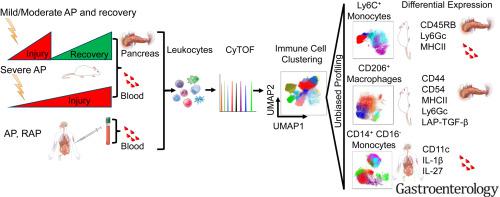Gastroenterology ( IF 29.4 ) Pub Date : 2021-08-25 , DOI: 10.1053/j.gastro.2021.08.033 Murli Manohar 1 , Elaina K Jones 1 , Samuel J S Rubin 2 , Priyanka B Subrahmanyam 3 , Gayathri Swaminathan 2 , David Mikhail 2 , Lawrence Bai 2 , Gulshan Singh 2 , Yi Wei 2 , Vishal Sharma 2 , Janet C Siebert 4 , Holden T Maecker 3 , Sohail Z Husain 5 , Walter G Park 2 , Stephen J Pandol 6 , Aida Habtezion 7

|
Background And Aims
Acute pancreatitis (AP) is an inflammatory disease with mild to severe course that is associated with local and systemic complications and significant mortality. Uncovering inflammatory pathways that lead to progression and recovery will inform ways to monitor and/or develop effective therapies.
Methods
We performed single-cell mass Cytometry by Time Of Flight (CyTOF) analysis to identify pancreatic and systemic inflammatory signals during mild AP (referred to as AP), severe AP (SAP), and recovery using 2 independent experimental models and blood from patients with AP and recurrent AP. Flow cytometric validation of monocytes subsets identified using CyTOF analysis was performed independently.
Results
Ly6C+ inflammatory monocytes were the most altered cells in the pancreas during experimental AP, recovery, and SAP. Deep profiling uncovered heterogeneity among pancreatic and blood monocytes and identified 7 novel subsets during AP and recovery, and 6 monocyte subsets during SAP. Notably, a dynamic shift in pancreatic CD206+ macrophage population was observed during AP and recovery. Deeper profiling of the CD206+ macrophage identified 7 novel subsets during AP, recovery, and SAP. Differential expression analysis of these novel monocyte and CD206+ macrophage subsets revealed significantly altered surface (CD44, CD54, CD115, CD140a, CD196, podoplanin) and functional markers (interferon-γ, interleukin 4, interleukin 22, latency associated peptide-transforming growth factor–β, tumor necrosis factor-α, T-bet, RoRγt) that were associated with recovery and SAP. Moreover, a targeted functional analysis further revealed distinct expression of pro- and anti-inflammatory cytokines by pancreatic CD206+ macrophage subsets as the disease either progressed or resolved. Similarly, we identified heterogeneity among circulating classical inflammatory monocytes (CD14+CD16-) and novel subsets in patients with AP and recurrent AP.
Conclusions
We identified several novel monocyte/macrophage subsets with unique phenotype and functional characteristics that are associated with AP, recovery, and SAP. Our findings highlight differential innate immune responses during AP progression and recovery that can be leveraged for future disease monitoring and targeting.
中文翻译:

胰腺炎和恢复中的新型循环和组织单核细胞以及巨噬细胞
背景和目标
急性胰腺炎 (AP) 是一种炎症性疾病,病程从轻到重,与局部和全身并发症以及高死亡率有关。发现导致进展和恢复的炎症通路将为监测和/或开发有效疗法提供信息。
方法
我们通过飞行时间 (CyTOF) 分析进行了单细胞质量流式细胞术,以使用 2 个独立的实验模型和来自具有AP 和复发性 AP。使用 CyTOF 分析识别的单核细胞亚群的流式细胞术验证是独立进行的。
结果
在实验性 AP、恢复和 SAP 期间,Ly6C +炎性单核细胞是胰腺中变化最大的细胞。深度分析揭示了胰腺和血液单核细胞之间的异质性,并在 AP 和恢复期间确定了 7 个新的亚群,在 SAP 期间确定了 6 个单核细胞亚群。值得注意的是,在 AP 和恢复期间观察到胰腺 CD206 +巨噬细胞群的动态变化。对 CD206 +巨噬细胞的更深入分析在 AP、恢复和 SAP 期间确定了 7 个新的子集。这些新型单核细胞和 CD206 +的差异表达分析巨噬细胞亚群显示显着改变的表面(CD44、CD54、CD115、CD140a、CD196、podoplanin)和功能标记(干扰素-γ、白细胞介素 4、白细胞介素 22、潜伏期相关肽转化生长因子-β、肿瘤坏死因子-α、T -bet, RoRγt) 与恢复和 SAP 相关。此外,有针对性的功能分析进一步揭示了随着疾病的进展或消退,胰腺 CD206 +巨噬细胞亚群的促炎细胞因子和抗炎细胞因子的不同表达。同样,我们在 AP 和复发性 AP 患者中确定了循环经典炎症单核细胞 (CD14 + CD16 - ) 和新亚群之间的异质性。
结论
我们鉴定了几种具有独特表型和功能特征的新型单核细胞/巨噬细胞亚群,这些亚群与 AP、恢复和 SAP 相关。我们的研究结果强调了 AP 进展和恢复期间的先天免疫反应差异,可用于未来的疾病监测和靶向。



























 京公网安备 11010802027423号
京公网安备 11010802027423号